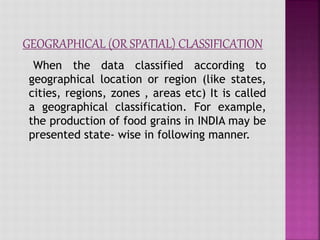Classification of data
- 1. CLASSIFICATIONOF DATA Prepaired by Rajni Bala M.Lib, M.Phil Department of Library and Information Sciences Kurukshetra University
- 2. “Classification is the process of arranging things(either normally or notionally) in groups or classes according to their resemblances and affinities and give expressions of the unity attributes that may subsist amongst a diversity individuals”. - Conner
- 3. Bulk of the data Simplifies of the data Facilitates comparison of characteristics Renders the data for statistical analysis
- 4. Unambiguous Stable Flexible Exhaustiveness Mutually exclusive
- 5. To condense the mass of data To prepare the data for tabulation To study the relationships To facilitate comparison
- 6. Geographical (or spatial) classification Chronological classification Qualitative classification Quantitative classification Alphabetical classification
- 7. When the data classified according to geographical location or region (like states, cities, regions, zones , areas etc) It is called a geographical classification. For example, the production of food grains in INDIA may be presented state- wise in following manner.
- 8. S.NO. Name of states Total food grains (thousands tones) 1 ANDHRA PARDESH 1093.90 2 BIHAR 12899.89 3 KARNATAKA 1834.78 4 PUNJAB 21788.20 5 UTTER PRADESH 41828.30
- 9. When data are observed over a period of time the type of classification is known as chronological classification ( on the basis of its time of occurrence ). Various the serious such as National income figures , annual output of wheat monthly expenditure of a house hold , daily consumptions of milk, etc. Are some examples of chronological classification . For examples we may present the figures of population (or production , sales,etc.) as follows……
- 10. S.No. year Population in crores 1 1941 31.87 2 1951 36.11 3 1961 43.91 4 1971 54.82 5 1981 68.33
- 11. We may first divide the population in to males and females on the basis of the attribute ‘sex’, each of this class may be further subdivide into ‘literate’ and ‘illiterate’ on the basis of attribute ‘literacy’ further classification can be made on the basis of same other attribute ,say , employment.
- 12. Quantitative classification is refers to the classification of data according to some characteristics that can be measured, such as height, weight ,income, sales profit, production,etc. For example, the student of a college may be classified according to weight as follows:
- 13. Weight (kg) No. of Students 40-50 60 50-60 50 60-70 28 70-80 20 80-90 12 Total 170
- 14. When the data are arranged according to alphabetical order, it is called alphabetical classification. For example state-wise density of population in India is depicted in an alphabetical order below;
- 15. Names of States Density of Population (Per Sq. Km) Andhra Pradesh 157 Assam 150 Bihar 324 Gujarat 136 Haryana 225 Himachal Pradesh 62 Kerala 548
Editor's Notes
- #3: And g
















